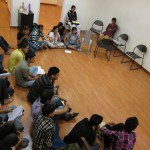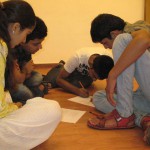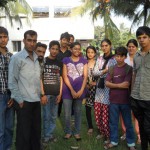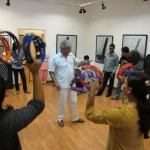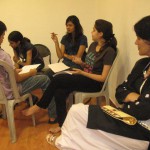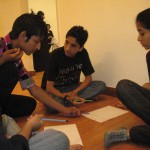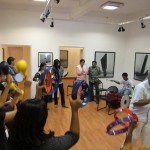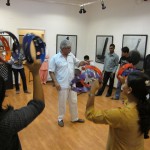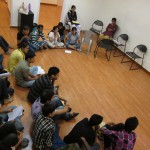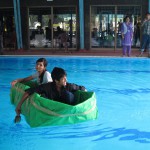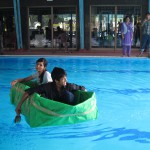A ‘Mathematical’ problem, Japanese Counting and Plenty of Games
The class eleven and twelve students of Lakshmipat Singhania Academy (Kolkata) participated in a workshop that was a part of our Kashmir Project . However, the children from Kashmir came from different parts of the state and so most of them were meeting each other for the first time. Quite unsure of what they would be asked to do, the children from Kashmir, a bunch of gangly teenagers and the children from Kolkata not quite different from their counterparts sat together. The feeling of enthusiasm and expectation bound them together. And that is when Jayant Kriplani introduced his unconventional way of “teaching”. Students instinctively christened him ‘Jayant Sir’ but their new teacher was quite unlike their school teachers. They soon learnt that their new Sir would not be providing them with any answers but rather lead them on the path to self discovery and understanding. The first lesson at de-programming began when Jayant Sir challenged his students to memorize Japanese counting from 1-10. An awkward fear of the unknown and impossibility clouded the faces of the twenty odd students. Again, the Kashmiri children and the children from Kolkata seemed to be tied together by a common feeling of confusion. How could they possibly memorize the Japanese numericals in only ten minutes?? But oh they did! and how!
‘Jayant Sir’ however was not satisfied with the children’s ability to only mindlessly memorize, his lesson was meant to teach them something else altogether. Thus the rest of the day was spent in playing a variety of theatre games.
Games and exercises that dealt with the art of conversation—building trust and imparting confidence to one another—true communication. At the end of the day each child was asked to write down their New Year resolution. They had to keep it aside for the last day. At last when the workshop ended for the day, the children were invited to introspect on their day’s exercise and reflect upon the lessons learnt. “Method to memorize fast”, “Learn from Symbols”, “Converse with each other”, “Trust each other”, “Think from Multiple perspectives”, “And Nothing is Impossible” were the mantras that were seen scribbled on the white board. The children from Kashmir and Kolkata had moved out of their social groups, at least for the time they played or learnt they were together.
The evening was spent watching theatre performances by students of 15 different schools—part of an Annual Inter School Drama Festival.
The 15 Famous Minutes
On the second day the children had squared themselves for yet another day’s lesson and perhaps another opportunity to know each other. By now they knew each other’s names and had also coined nicknames for their favorites- Beautiful Bazila, Sweet Amin, and Talkative Ishrat were some that the Kolkata students would use for their Kashmiri friends for the next few days. The children from Kashmir had their own sobriquets- the Chinese girl, Nivi. The tiniest hint of slow camaraderie was evident as the children were leaving their polite masks and getting boisterous around each other. By the time Jayant Sir divided them into the groups again, the consternation of the first day, the blank faces and initial discomfort had dissolved a little. They were now a bit more comfortable around each other. That is when each group was given 5 sentences and asked to use these sentences in a short script of their own. The idea was to prepare a script for a 15 minute short film that the groups would shoot as soon as they got their scripts ready. The children took the whole day to script their maiden films. Their scripts reflected a variety of themes. Some had taken inspiration from Bollywood films whereas others used themes from daily news report.
The script writing exercise was followed by group readings and sharing of the scripts with otehrs and then planning and preparation to shoot the scripts the following day. Now shooting the films was no child play and these children were dedicated amateurs at work. Some were rehearsing half a dozen times before shooting whereas some precipitated into the act of shooting and directing right away. It was not easy and it surely was a bit messy. With four films and twenty filmmakers, actors and camerapersons, the center’s studio was busier than a bee’s hive. There was some squabbling for space, some confusion over the camera and some distress over right acting and dialogue delivery. If in one group Beautiful Bazilla was being asked to carry herself demurely then in another Nivedita was fuming as her group members were not taking her seriously. In their squabbles as in their jest they seemed a little less distinct from each other.
As the days progressed the activities got more and more challenging and interesting, interspersed with visits to places of attraction in the city and above all experiencing the special magic of the Durga Puja, a festival that is celebrated in Calcutta like nowhere else in the country.
All the activities—the ones described here—the making of boats out of cardboard and sailing in them—learning to play musical instruments, learning about rhythm and forming an orchestra in just over 60 minutes—learning about photography and its use in social media to keep in touch woth friends world wide—all of this and more had one underlying theme—that the participants who came from Kashmir went back with life long bonds and an inner strength and confidence that will allow them to focus on building a future for themselves despite the circumstances they live in.
The fact that at the end of the sessions the youngsters from the local school were so moved and inspired by their peers from Kashmir that they sought special permission from their school to allow their Kashmiri friends to attend a regular day at school with them so that the entire school could meet and interact with them. This was proof for us at Seagull that the seeds of building bridges have been sown.


